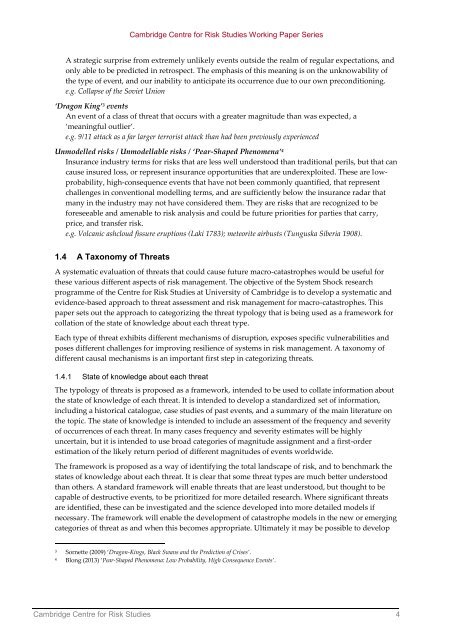A Taxonomy of Threats for Macro-Catastrophe Risk Management
A Taxonomy of Threats for Macro-Catastrophe Risk Management
A Taxonomy of Threats for Macro-Catastrophe Risk Management
You also want an ePaper? Increase the reach of your titles
YUMPU automatically turns print PDFs into web optimized ePapers that Google loves.
Cambridge Centre <strong>for</strong> <strong>Risk</strong> Studies Working Paper SeriesA strategic surprise from extremely unlikely events outside the realm <strong>of</strong> regular expectations, andonly able to be predicted in retrospect. The emphasis <strong>of</strong> this meaning is on the unknowability <strong>of</strong>the type <strong>of</strong> event, and our inability to anticipate its occurrence due to our own preconditioning.e.g. Collapse <strong>of</strong> the Soviet Union‘Dragon King’ 3 eventsAn event <strong>of</strong> a class <strong>of</strong> threat that occurs with a greater magnitude than was expected, a‘meaningful outlier’.e.g. 9/11 attack as a far larger terrorist attack than had been previously experiencedUnmodelled risks / Unmodellable risks / ‘Pear-Shaped Phenomena’ 4Insurance industry terms <strong>for</strong> risks that are less well understood than traditional perils, but that cancause insured loss, or represent insurance opportunities that are underexploited. These are lowprobability,high-consequence events that have not been commonly quantified, that representchallenges in conventional modelling terms, and are sufficiently below the insurance radar thatmany in the industry may not have considered them. They are risks that are recognized to be<strong>for</strong>eseeable and amenable to risk analysis and could be future priorities <strong>for</strong> parties that carry,price, and transfer risk.e.g. Volcanic ashcloud fissure eruptions (Laki 1783); meteorite airbusts (Tunguska Siberia 1908).1.4 A <strong>Taxonomy</strong> <strong>of</strong> <strong>Threats</strong>A systematic evaluation <strong>of</strong> threats that could cause future macro-catastrophes would be useful <strong>for</strong>these various different aspects <strong>of</strong> risk management. The objective <strong>of</strong> the System Shock researchprogramme <strong>of</strong> the Centre <strong>for</strong> <strong>Risk</strong> Studies at University <strong>of</strong> Cambridge is to develop a systematic andevidence-based approach to threat assessment and risk management <strong>for</strong> macro-catastrophes. Thispaper sets out the approach to categorizing the threat typology that is being used as a framework <strong>for</strong>collation <strong>of</strong> the state <strong>of</strong> knowledge about each threat type.Each type <strong>of</strong> threat exhibits different mechanisms <strong>of</strong> disruption, exposes specific vulnerabilities andposes different challenges <strong>for</strong> improving resilience <strong>of</strong> systems in risk management. A taxonomy <strong>of</strong>different causal mechanisms is an important first step in categorizing threats.1.4.1 State <strong>of</strong> knowledge about each threatThe typology <strong>of</strong> threats is proposed as a framework, intended to be used to collate in<strong>for</strong>mation aboutthe state <strong>of</strong> knowledge <strong>of</strong> each threat. It is intended to develop a standardized set <strong>of</strong> in<strong>for</strong>mation,including a historical catalogue, case studies <strong>of</strong> past events, and a summary <strong>of</strong> the main literature onthe topic. The state <strong>of</strong> knowledge is intended to include an assessment <strong>of</strong> the frequency and severity<strong>of</strong> occurrences <strong>of</strong> each threat. In many cases frequency and severity estimates will be highlyuncertain, but it is intended to use broad categories <strong>of</strong> magnitude assignment and a first-orderestimation <strong>of</strong> the likely return period <strong>of</strong> different magnitudes <strong>of</strong> events worldwide.The framework is proposed as a way <strong>of</strong> identifying the total landscape <strong>of</strong> risk, and to benchmark thestates <strong>of</strong> knowledge about each threat. It is clear that some threat types are much better understoodthan others. A standard framework will enable threats that are least understood, but thought to becapable <strong>of</strong> destructive events, to be prioritized <strong>for</strong> more detailed research. Where significant threatsare identified, these can be investigated and the science developed into more detailed models ifnecessary. The framework will enable the development <strong>of</strong> catastrophe models in the new or emergingcategories <strong>of</strong> threat as and when this becomes appropriate. Ultimately it may be possible to develop3Sornette (2009) ‘Dragon-Kings, Black Swans and the Prediction <strong>of</strong> Crises’.4Blong (2013) ‘Pear-Shaped Phenomena: Low Probability, High Consequence Events’.Cambridge Centre <strong>for</strong> <strong>Risk</strong> Studies 4


